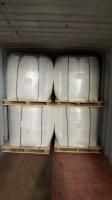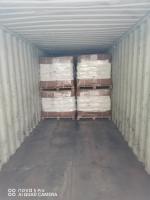Our Products
Polyacrylamide / anionic polyacryamide emulsion of FLOPAM DW 533 can be replaced by Chinafloc EM779
305_small.jpg)
FLOPAM DW 533 is an anionic polyacrylamide emulsion manufactured by SNF Floerger, one of the global leaders in water-soluble polymer production. Designed specifically for solid-liquid separation processes, FLOPAM DW 533 is widely used in water treatment, sludge dewatering, mining, paper manufacturing, and several other industries. Its high molecular weight and tailored anionic charge make it particularly suitable for flocculating suspended particles, enhancing sedimentation, and improving filtrate clarity in various systems.
1. Municipal Water and Wastewater Treatment
Municipal treatment plants face ongoing challenges related to growing urban populations, higher regulatory standards, and the need to recycle and reuse water. FLOPAM DW 533 addresses several of these challenges through effective flocculation, making it integral to the following processes:
a. Primary Clarification
FLOPAM DW 533 helps in removing large volumes of suspended solids from raw sewage by aggregating fine particles into larger flocs, making them easier to settle in primary clarifiers. This enhances the overall performance of downstream biological processes.
b. Secondary Clarification
In activated sludge systems, FLOPAM DW 533 improves the settling of biological flocs. This results in clearer secondary effluent and allows the sludge to be more efficiently recycled or dewatered.
c. Tertiary Polishing
To meet increasingly stringent effluent standards, some treatment plants apply FLOPAM DW 533 during tertiary treatment stages to reduce turbidity, residual suspended solids, and phosphorus levels.
d. Sludge Conditioning
The product significantly improves sludge thickening and dewatering efficiency in belt filter presses, centrifuges, and screw presses by promoting better water release and reducing polymer demand in long-term operations.
2. Industrial Wastewater Treatment
Industrial effluents are often complex and contain a mix of organic materials, heavy metals, oils, greases, and suspended solids. FLOPAM DW 533 provides a robust solution across a variety of industrial sectors:
a. Textile and Dyeing
In dye wastewater, the product helps coagulate and settle colloidal dyes, improving water clarity and reducing chemical oxygen demand (COD) and color.
b. Pulp and Paper
FLOPAM DW 533 is used in white water clarification, fiber recovery, and effluent treatment. It facilitates the removal of fine suspended fibers and fillers, promoting water reuse and reducing chemical loading on biological systems.
c. Food and Beverage
It is effective in separating organic solids, fats, and proteins in effluents from dairies, slaughterhouses, and breweries. It helps reduce the organic load before biological treatment or discharge.
d. Chemical and Petrochemical
Used for treating process water and effluents that contain hydrocarbons, suspended solids, and other contaminants. It also enhances the performance of Dissolved Air Flotation (DAF) systems.
3. Sludge Thickening and Dewatering
One of the most critical and cost-intensive parts of wastewater treatment is sludge handling. FLOPAM DW 533 supports multiple sludge treatment operations:
a. Gravity Thickeners
Improves the thickening process by encouraging the rapid settling of solids and increasing the solid concentration in sludge.
b. Belt Filter Presses
Increases cake dryness and throughput, reducing polymer consumption and sludge transport costs.
c. Centrifuges
FLOPAM DW 533 improves the separation efficiency and enhances cake solid content while minimizing filtrate turbidity.
d. Screw Presses
The anionic polymer enhances floc formation and improves filtration by allowing easier passage of water through filter media.
4. Mining and Mineral Processing
In mining operations, particularly those that deal with fine clays and mineral suspensions, FLOPAM DW 533 is widely applied in:
a. Thickener Feed
Used to improve the settling of finely dispersed solids in thickeners. It increases underflow density and improves overflow clarity in tailings thickeners.
b. Tailings Dewatering
Assists in separating water from tailings before disposal, reducing the volume of material handled and lowering environmental impact.
c. Process Water Clarification
Enhances recovery and recycling of process water, reducing freshwater usage and improving sustainability.
d. Bauxite and Alumina Production
FLOPAM DW 533 is used in the clarification of sodium aluminate liquor and red mud settling, especially in Bayer process operations.
e. Coal Washing
Flocculates fine coal particles and clay in water streams to enhance sedimentation and reduce suspended solids.
5. Oil and Gas Industry Applications
In the energy sector, particularly oil and gas extraction and refining, FLOPAM DW 533 is used to treat complex wastewater streams and improve the efficiency of various separation processes.
a. Produced Water Treatment
It flocculates suspended solids and oil droplets in produced water to enable easier removal by flotation or sedimentation.
b. Fracturing Flowback Treatment
After hydraulic fracturing, return fluids (flowback) contain sand, clay, and residual chemicals. FLOPAM DW 533 helps settle these solids, making the water suitable for reuse or disposal.
c. Drilling Mud Clarification
The polymer helps in recovering valuable drilling fluids and separating suspended solids from drilling return fluids.
6. Power Plants and Desalination
FLOPAM DW 533 is employed in cooling water treatment and desalination pre-treatment systems to reduce suspended solids and biofouling potential. It also enhances water quality in ash pond effluent and scrubber wastewater in coal-fired plants.
7. Performance Factors and Optimization
To achieve maximum efficiency with FLOPAM DW 533, certain operational conditions and practices must be optimized:
-
pH Range: Works effectively in the pH range of 5.5 to 9.5. Outside this range, charge interaction with suspended particles may be reduced.
-
Dilution: Typically diluted to 0.1%–0.5% before use to ensure uniform application and reduce the risk of overdosing.
-
Mixing and Activation: Requires slow and gentle agitation to ensure full inversion of the emulsion and activation of the polymer chains.
-
Dosage: Can vary widely based on the application, but typical dosing is between 2 and 50 ppm for water clarification and higher for sludge dewatering.
-
Compatibility: May be used alongside coagulants (e.g., alum, ferric chloride, or polyaluminum chloride) for improved performance in coagulation-flocculation systems.
8. Environmental and Economic Benefits
FLOPAM DW 533 offers substantial environmental and economic advantages:
-
Improved Water Quality: Produces cleaner effluent with lower total suspended solids (TSS), turbidity, and organic load.
-
Reduced Sludge Volume: Promotes faster water release, leading to drier sludge and lower handling costs.
-
Lower Polymer Consumption: Its high efficacy often results in lower overall polymer use compared to lower-performance alternatives.
-
Enhanced Resource Recovery: Enables reuse of water in closed-loop industrial systems and supports zero-liquid-discharge (ZLD) strategies.
9. Packaging, Storage, and Safety
-
Form: FLOPAM DW 533 is supplied as a stable emulsion for easy handling and rapid dissolution.
-
Storage: Should be kept between 5°C and 35°C, away from direct sunlight and frost.
-
Shelf Life: Generally 6 to 9 months under proper storage conditions.
-
Safety: Non-toxic and non-corrosive in diluted form, but care should be taken to prevent slips and spills due to its slippery nature.
Conclusion
FLOPAM DW 533 is a high-efficiency anionic polyacrylamide emulsion with broad industrial utility. From municipal and industrial water treatment to mining, oil and gas, and sludge dewatering, its versatility and superior flocculation performance make it a cornerstone product in solid-liquid separation. Its ability to function in diverse conditions, reduce treatment costs, and enhance environmental compliance ensures its widespread adoption across the globe. Whether improving effluent clarity or optimizing sludge handling, FLOPAM DW 533 continues to set benchmarks in water management efficiency.





